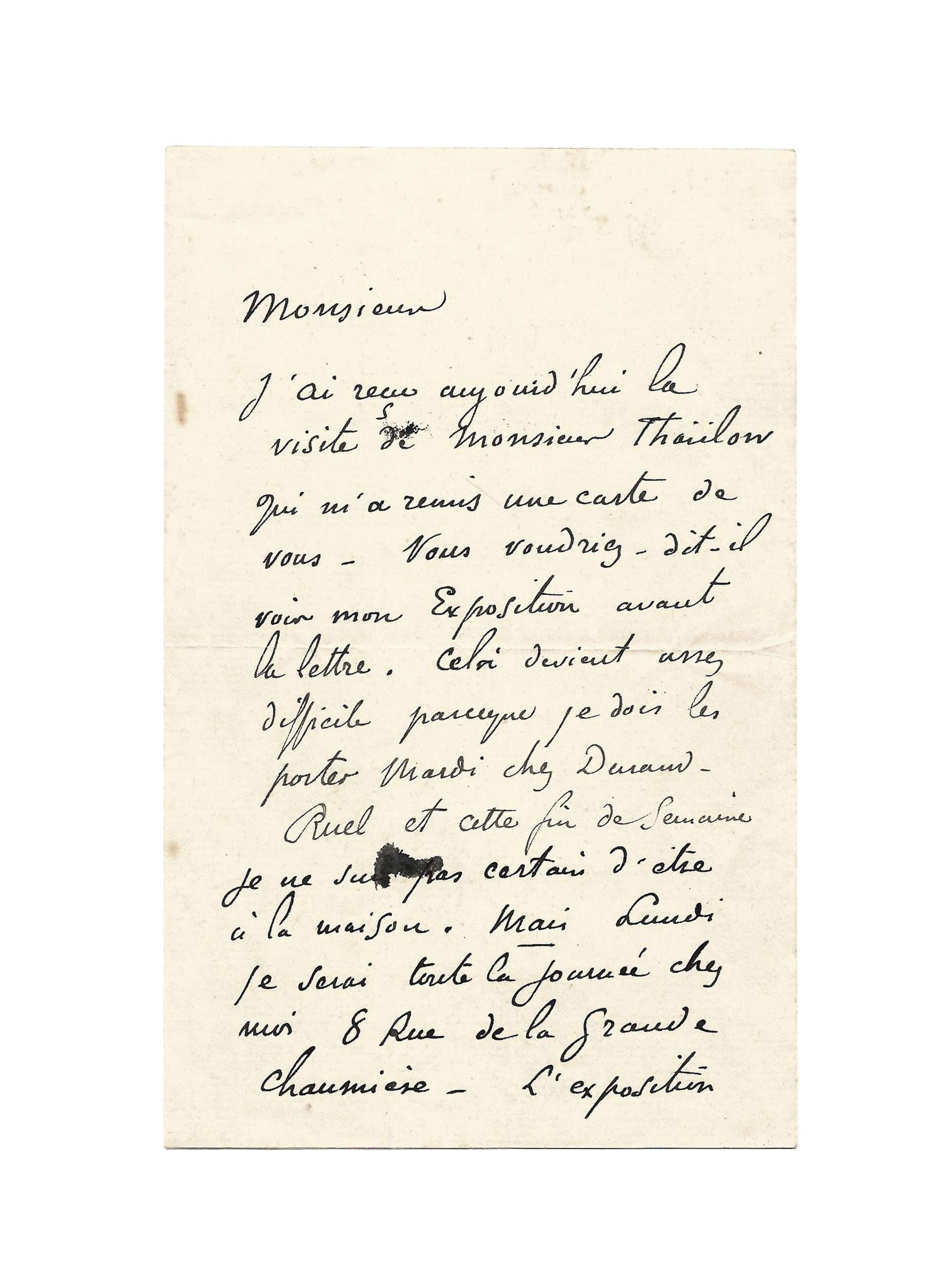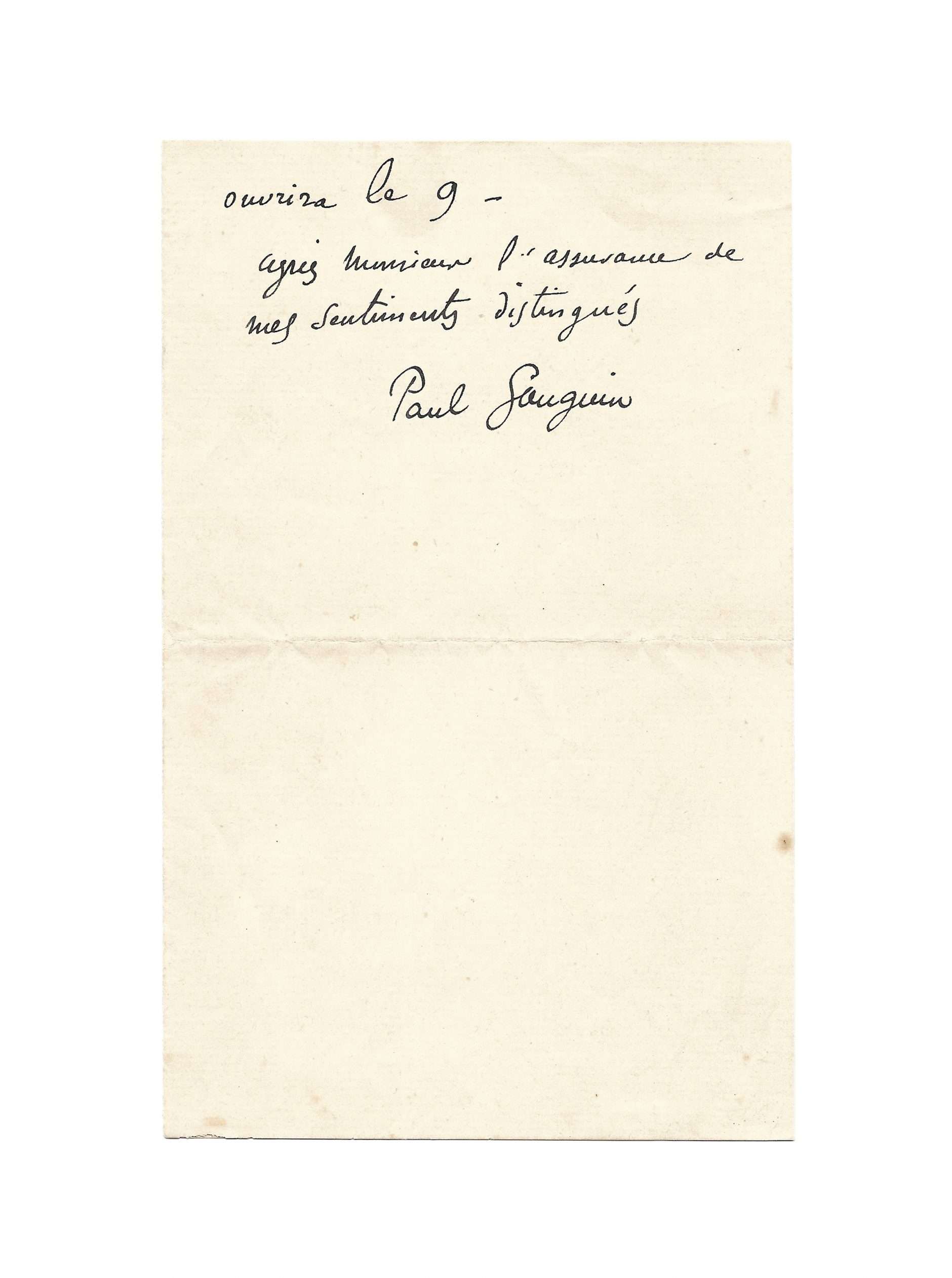GAUGUIN, Paul (1848-1903)
Autograph letter signed « Paul Gauguin » to a collector
N.p.n.d [Paris, 1st or 2nd November 1893], 1 p. 1/2 in-8°
« The exhibition will be launched on the 9th »
Fact sheet
GAUGUIN, Paul (1848-1903)
Autograph letter signed « Paul Gauguin » to a collector
N.p.n.d [Paris, 1st or 2nd November 1893], 1 p. 1/2 in-8°
Some tiny spots, ink stain
Back from his first trip to Tahiti, Gauguin launches his exhibition at the Durand-Ruel gallery
« Monsieur, J’ai reçu aujourd’hui la visite de monsieur Thaülow [Fritz Thaulow his step-brother] qui m’a remis une carte de vous. Vous voudriez – dit-il voir mon exposition avant la lettre. Cela devient assez difficile parce que je dois les porter [his paintings] mardi chez Durand-Ruel et cette fin de semaine je ne suis pas certain d’être à la maison. Mais lundi je serai toute la journée chez moi 8 rue de la Grande Chaumière – L’exposition ouvrira le 9. Agréez monsieur l’assurance de mes sentiments distingués.
Paul Gauguin. »
After two years of a bohemian life and passionate work in the Pacific islands, Gauguin returned to France and arrived in Marseille on August 4, 1893. The artist is penniless. Wishing to organize an exhibition of his Tahitian works as soon as possible, he will then play his relations, especially with Degas, whose support will allow him to exhibit at the Durand-Ruel, rue Lafitte, for a month. The opening is scheduled for November 4.
Gauguin struggles but already imagines a great success, money flowing, and the protection of a Parisian merchant; His Tahitian works are sublime. However, he made a big mistake, setting the prices of his works himself at too high sums – between 2 and 3000 francs, or nearly ten times the prices charged before his departure – claiming then to increase his rating.
The opening is postponed to November 9 and the whole Paris of the arts is invited: journalists, dealers, critics, collectors, writers, and the painters Pissarro, Monet, Renoir and of course Degas.
Gauguin exhibited a total of forty-four paintings including La Orana Maria (Ave Maria), Manao tupapau (The Spirit Watches), Metua rahi no Tehamana (My Ancestors of Tehamana), or Nafea faaipoipo (When do you get married?), which remain among his most famous works.
He is anxious and plays big. On the evening of the opening, the Durand-Ruel gallery is full but Gauguin quickly understands that the game is lost and that he will sell nothing, or almost nothing. Charles Morice recounts: “In the vast gallery where his painted vision blazed on the walls, he looked at the public, he listened. Soon he had no doubt: we did not understand. It was the definitive separation between Paris and him, all his great projects were ruined, and, wound perhaps for this proud, the cruelest of all, he had to admit to himself that he had badly combined his plans. »
Misunderstanding and too high prices, the exhibition at Durand-Ruel is a financial disaster. Only eight paintings are sold. The press was nevertheless generally very enthusiastic about the painter’s work: Mallarmé, Cardon, Darien and Mirbeau were unanimous, hailing the work of a great master.
Eighteen months later, Gauguin left for his second and last trip to the Pacific…
We attach :
The facsimile of the exhibition catalogue at Durand-Ruel, with the preface by Charles Morice and the list of works
1 vol. (13.8 x 21.2 cm), half leather burgundy with corners, nerved spine, golden title letters.
Bibliographic references:
Lettres de Gauguin à Georges-Daniel de Monfreid. Crès, 1918
Gauguin à Tahiti et aux îles Marquises. Bengt Danielsson, Editions du Pacifique, 1975
Gauguin, David Haziot, Fayard, 2017



